Testing the authenticity of gold is a topic that has intrigued many curious minds. With the rising popularity of DIY methods, people are often left wondering if they can test gold using simple household tools like a lighter. In this blog post, we will delve into the world of gold testing, debunking popular myths and shedding light on the most effective methods to determine if your gold is real or fake.
We will address common questions such as: Does pure gold turn black when exposed to flame? Can you stamp fake gold with specific markings? Why does gold sometimes turn pink or green? Is the weight of gold a reliable indicator of its authenticity? Join us as we uncover the truth behind popular gold testing methods, exploring techniques that can be easily performed at home.
So, if you’ve ever wondered how to test gold using materials readily available in your own household, this blog post is for you. Discover the answers to your burning questions and gain valuable insights into the world of gold testing, all without the need for complicated laboratory equipment. Get ready to unravel the mysteries of gold testing and become an expert at distinguishing genuine gold from clever imitations.

Can Gold Be Tested with a Lighter
Gold has long been associated with wealth, luxury, and elegance. But what if you stumble upon a piece of gold and want to determine its authenticity? Can you simply whip out a lighter and put it to the test? Let’s find out.
The Science Behind Gold Testing
While gold is known for its durability and resistance to tarnish, it does have a melting point of 1,064 degrees Celsius (1,947 degrees Fahrenheit). This means that under extreme heat, gold will eventually turn into a liquid state. So, it seems logical to assume that using a lighter would be a simple and effective way to test if a piece of gold is real, right? Well, not quite.
Debunking the Lighter Myth
Contrary to popular belief, using a lighter as a definitive test for gold authenticity is not accurate. Here’s why: the flame produced by a lighter is simply not hot enough to reach the melting point of gold. So, while your gold jewelry might bear witness to your fashion sense, it won’t provide any insights into its authenticity when exposed to a lighter flame.
Other Methods for Testing Gold
If the lighter approach is out of the equation, are there other methods one can employ to determine if a piece of gold is genuine? Absolutely! Several effective testing methods are commonly used by professionals and enthusiasts alike. Let’s explore a few of them:
1. Acid Tests
Acid tests involve the use of nitric acid to assess the purity of gold. By applying a small amount of acid to the gold item, any reaction or discoloration can indicate a lower purity level. This method primarily works because gold is highly resistant to most acids, while other metals used in counterfeit gold alloys may react differently.
2. Magnet Test
Gold is not magnetic, so employing a simple magnet can help you determine if your gold is genuine. If your gold piece is attracted to the magnet, it likely contains other metals and is not pure gold. However, keep in mind that while this test can identify some counterfeit gold, it’s not foolproof, as some non-magnetic metals can still be present in genuine gold jewelry.
3. Density Test
Another method to determine gold authenticity is the density test. Genuine gold is denser than most metals used in counterfeits. By measuring the weight of the gold item and comparing it to its volume, one can calculate its density. Professional jewellers have access to specialized equipment that simplifies this process.
Trust the Experts
While testing gold with a lighter may sound like an entertaining idea, it’s important to rely on more accurate methods to ensure reliability. Seek professional advice from experienced jewelers or employ trusted testing techniques like acid tests, magnet tests, or density tests. Remember, a solid investment is worth the effort of verifying authenticity. So, leave the lighters for candlelight and let the experts handle your gold testing needs.

FAQ: Can you test gold with a lighter
Does Pure Gold Turn Black
No, pure gold does not turn black. Gold is known for its resistance to oxidation and tarnishing. It’s one of the reasons why it’s highly valued and sought after.
Can You Stamp Fake Gold
Fake gold can indeed be stamped to make it appear authentic. Some dishonest individuals may try to pass off counterfeit gold as genuine by adding fake stamps or markings. This is why it’s important to use other reliable methods to determine the authenticity of gold.
Why Is My Gold Turning Pink
Gold turning pink is often a sign of low-quality or impure gold. It can be attributed to the presence of other metals or alloys, such as copper, that may react with oxygen or other elements when exposed to certain conditions.
Does Gold Turn Green
Gold itself does not turn green. However, gold jewelry may appear green when it is made with alloys that contain metals like copper or silver. This greenish tint is usually the result of a chemical reaction between the metal and acids in the wearer’s skin or the environment.
Is Real Gold Heavy or Light
Real gold is relatively heavy compared to many other metals. Its density gives it a noticeable weight when you hold it in your hand. This characteristic is often used as a simple test for determining if a piece of jewelry is made of real gold.
How Can You Test Gold at Home with Water
Testing gold at home with water is not a reliable method. Gold is non-reactive to water, so it won’t dissolve or change when submerged. Other methods like acid testing or using a professional gold testing kit are more accurate for at-home testing.
How Can I Test Gold at Home
There are a few ways you can test gold at home. One method is to carefully observe the gold’s color and shine. Genuine gold will maintain its distinct yellow color and beautiful luster. Additionally, you can perform an acid test or use a professional gold testing kit for more accurate results.
Will Gold Stick to a Magnet
No, gold is not magnetic and will not stick to a magnet. This property is one of the characteristics that can help distinguish gold from other metals. If you come across a piece of “gold” that sticks to a magnet, it’s likely a fake or contains a high amount of iron or other magnetic metals.
Does Gold Change Color in Water
Pure gold does not change color when exposed to water. It remains its distinct yellow hue and does not react chemically with water. However, certain impurities or alloys used in gold jewelry-making may react differently when exposed to water, causing a change in color.
Does Gold Turn Black When You Burn It with a Lighter
No, gold does not turn black when exposed to heat from a lighter. Real gold has a high melting point, and its properties make it resistant to changes in color or appearance when heated. If a piece of gold turns black when you burn it, it’s likely not genuine gold.
Is Gold Solid, Liquid, or Gas
Gold is a solid metal at room temperature. It has a melting point of 1,064 degrees Celsius (1,947 degrees Fahrenheit) and a boiling point of 2,808 degrees Celsius (5,086 degrees Fahrenheit). This makes it a popular choice for jewelry and other valuable items.
Does Vinegar Clean Gold
Vinegar can be used to clean gold, but it is not recommended for all types of gold jewelry. While vinegar can effectively remove dirt and grime, it may damage delicate or porous gold pieces. It’s always best to consult with a professional jeweler for proper cleaning methods.
How Can You Tell if Something is 14K Gold
To determine if something is 14K gold, you can look for specific markings or stamps on the item. Jewelry marked with “14K” or “585” indicates that it contains 14 parts gold and 10 parts other metals, making it 58.5% pure gold. A professional jeweler can also perform acid testing for a more accurate assessment.
Does Vinegar Hurt Gold
Vinegar can potentially damage certain types of gold jewelry. Its acidic properties can cause discoloration, tarnishing, or even corrosion, depending on the gold’s quality or purity. It’s advisable to seek professional advice on the appropriate cleaning methods for your specific gold items.
Does Fake Gold Sink in Water
In most cases, fake gold will sink in water. Genuine gold is relatively dense, so it tends to sink when compared to less dense materials. However, using water as the sole test for gold authenticity is not foolproof, as some counterfeit materials can mimic this characteristic.
How Can You Tell Real Gold from Fake
Several methods can help you determine real gold from fake. Look for specific markings or stamps indicating the gold’s purity, such as “24K” or “999” for pure gold. Conducting acid tests, using a professional gold testing kit, or seeking the expertise of a jeweler are more reliable ways to identify genuine gold.
How Do You Test Gold with Vinegar
To test gold with vinegar, you can follow these steps:
1. Place a few drops of vinegar on the gold item.
2. Observe if the gold undergoes any changes in color or appearance.
3. If the gold remains unchanged, it’s likely genuine. If it reacts by discoloring or tarnishing, it may be a sign of impurities or a lower gold content.
How Can You Tell if Something is Gold Plated or Brass
One way to determine if something is gold plated or brass is to conduct a simple acid test. Apply a small amount of nitric acid to an inconspicuous area of the item. If the area turns green or fades away, it’s likely brass. If the area remains unchanged, it may be gold plated.
What is the Easiest Way to Test Gold
The easiest way to test gold is to consult with a professional jeweler or utilize a gold testing kit. These methods provide accurate and reliable results without the risk of damaging or misinterpreting the characteristics of the gold.
How Do You Test Gold with Baking Soda
You can test gold with baking soda by following these steps:
1. Create a paste by mixing baking soda with water.
2. Rub the paste onto the gold item and observe any discoloration or reactions.
3. If the gold remains unchanged, it’s likely genuine. If it shows signs of discoloration or tarnishing, it may indicate impurities or a lower gold content.
How Can You Tell if Something is Gold or Gold-Plated
To determine if something is gold or gold-plated, you can conduct an acid test or seek the expertise of a professional jeweler. Another method is to look for specific markings or stamps indicating the gold’s purity. Gold-plated items often have a thin layer of gold over a different base metal.
How Can You Tell if Gold is Real at Home Without Acid
If you want to test gold authenticity at home without using acid, you can try these methods:
1. Observe the gold’s color and shine. Genuine gold maintains its yellow color and lustrous appearance.
2. Use a magnet to see if the gold is magnetic. Real gold is not attracted to magnets.
3. Seek the advice of a professional jeweler or use a reliable gold testing kit for more accurate results.
Stay tuned for more exciting facts about gold and its testing methods in our upcoming blog posts!